|
|
|
1.
|
The slope of the velocity versus time
graph is the acceleration (Fig 1 below).
The acceleration for:
(a) object A = (4 - 0)m/s/(4.0 - 0)s = 1.0 m/s2
(b) object B = (2 - 0)m/s/(4.0 - 0)s = 0.5 m/s2.
(c) mB/mA = aA/aB =
1.0/0.5 = 2. mB = 2mA = 2(2.0 kg) =
4.0 kg.
(d) Fnet = mAaA = mBaB
= (2.0 kg)(1.0 m/s2) = (4.0 kg)(0.5 m/s2)
= 2.0 N
|
|
|
2.
|
We again use the Principle of Superposition
in solving this problem by separating the problem into forces
acting along the horizontal or X-axis and those acting along
the vertical or Y-axis. Then all forces will be along a line.
We assign a positive or negative sign to the forces, depending
on their direction along the axis, and then add them algebraically.
There is no acceleration in the Y-direction, ay =
0.
|
(Fnet)y =
may = m(0) = 0
|
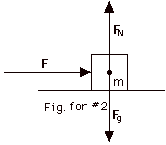 |
|
FN - Fg =
0 or FN = Fg = mg
|
(a) and (b). For m = 2.0 kg, FN = Fg
= (2.0 kg)(10 m/s2) = 20 N
(Fnet)x = max
(a) For F = 12 N, F = max or ax = F/m
= 12 N/2.0 kg= 6.0 m/s2
(b) For F =24 N, ax = 24 N/2.0 kg =
12.0 m/s2
The acceleration is directly proportional to the net force.
When you double the net force, you double the acceleration.
(c) For m = 1.0 kg, FN = Fg = (1.0 kg)(10
m/s2) = 10 N.
ax = 12 N/1.0 kg = 12 m/s2
The acceleration is inversely proportional to the mass of
the object. When you halve the mass, you double the acceleration.
|
|
|
3.
|
Now the net force in the X-direction
depends on an applied force to the right and a frictional
force to the left.
| |
(Fnet)x
= max
|
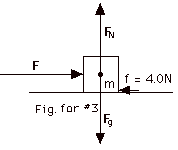 |
| |
F - f = max
|
|
(a)
|
12 N - 4 N = 2.0 kg ax
|
| |
4.0 m/s2 = ax
|
|
(b)
|
24 N - 4 N = 2.0 kg ax
|
| |
10 m/s2 = ax
|
While the applied force F is doubled,
the net force is not doubled and the acceleration is
not doubled. The second net force = 20/8 x the first
net force = 5/2 the first net force. The second acceleration
= 5/2 the first acceleration
= 5/2 x 4.0 m/s2 = 10 m/s2.
|
|
|
4.
|
In Fig. 4a below, I have isolated (shown
by dashed box) the entire system in order to find the acceleration
of the two blocks.
In Fig. 4b below, I have isolated A and
B separately in order to find FAB and FBA,
the force on A due to B and the force on B due to A, respectively.
FAB is an external force to
the system which consists only of A and FBA is
an external force to the system which consists only of B.
FAB and FBA are internal forces to the
system of Fig. 4a. I do not use a Y-axis in the figures because
I am not interested in the normal force and there is no friction
in the problem. For the entire system of Fig. 4a, I know the
external force that acts on it along the X-axis and I know
the mass of the system so I can find its acceleration. Since
I am interested only in the X-direction, I drop the subscript
x on Fnet and a.
| (a) |
Fnet external = (mass
of system)a
|
| |
12 N = (2 + 4)kg (a), or
|
| |
12 N/6 kg = 2 m/s2 =
a
|
Now we isolate block A to find FAB
since we know mA and a and then isolate block
B because we know everything but FBA, as shown
in Fig. 4b. F is only in contact with A and A pushes B to
the right, while B pushes A to the left.
| |
For
block A,
|
|
For
block B,
|
|
(b)
|
(Fnet external)on
A = (mA)a
|
(c) |
(Fnet external)on
B = (mB)a
|
| |
F - FAB = (2 kg)(2 m/s2)
|
|
FBA = (4 kg)(2 m/s2)
|
| |
12 N - FAB = 4 N or
FAB = 8 N
|
|
FBA = 8 N
|
FAB and FBA
are Newton third law of motion forces. They are equal
in magnitude, but opposite in direction. FAB,
the force of B on A, has a magnitude of 8 N and is to the
left. FBA, the force of A on B, has a magnitude
of 8 N and is to the right.
|
|
|
5.
|
In the figure below, FPF represents
the force of the floor on the person, FPR the force
of the rope on the person, FRP the force of the
person on the rope, FRH the force of the hook on
the rope, FHR the force of the rope on the hook,
and FHW the force of the wall on the hook. The
Newton third law of motion forces are: (1) FRP
and FPR, (2) FRH and FHR.
|
|
|
6.
|
It is a little difficult to solve (a)
of this problem without a sneak look at the figure for part
(b). So, both figures are shown immediately below:
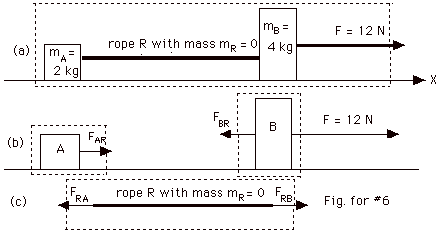 |
Fig. for #6a shows only the external
force in the horizontal direction acting on the system of
the two blocks. Again Fnet external = ma, where
a is the acceleration of the blocks and m is the mass of the
system we have isolated. There are internal forces acting
in the system, for example, the force of the rope on A, FAR,
the force of the rope on B, FBR. And we cannot
forget the force of A on the rope, FRA, or the
force of B on the rope, FRB. I have not drawn the
vectors for the gravitational forces on the blocks or the
normal force of the surface on the blocks because they were
not asked for and there is no frictional force. While Figures
for #6b and c show forces FAR, FBR, FRA
and FRB, these are internal to the system shown
in Fig. for #6a. The only external force for the entire
system in the horizontal direction is F = 12 N.
(a) Thus for the system shown in Fig. for #6a:
| |
(Fnet external)x
= (mass of system)a
|
| |
12 N = (2 + 4)kg (a), or
|
| |
12 N/6 kg = 2 m/s2 =
a
|
For part (b), let us stare at Fig. for
#6b and c above. Let's cope with the massless rope first:
| |
(Fnet external)on
rope = (mR)a
|
|
|
Taking
to the right to be positive,
|
FRB - FRA =
(0)a
|
where
a = the acceleration of the rope
|
| So, |
FRB = FRA
|
|
It is important to notice that FRB
and FRA, while equal and opposite in direction,
are not Newton third law of motion forces because they
act on the SAME object. They are equal and in the opposite
direction because they must sum to zero because a massless
object has no net force acting on it. Then by Newton's third
law we know that FRA = - FAR
and FRB = -FBR.
Thus since the magnitudes of these forces are equal, FRA
= FRB, FAR = FBR. We
throw all this careful notation to the wind and call FAR,
FBR, FRA and FRB the tension
T.
(b) Now we can choose either object to
find the tension T in the rope.You can check the answer by
isolating the other block and finding T.
|
For block B, in the X-direction
|
For block A, in the X-direction
|
|
(Fnet external)x
= (mB)a
|
(Fnet external)x
= (mA)a
|
|
12 N - T = (4 kg)(2 m/s2)
|
T = (2 kg)(2 m/s2) =
4 N
|
|
So 12 N - 8 N = T = 4 N
|
|
|
|
|
7.
|
The forces acting on the object are
the applied force F and the weight of the object mg. In all
cases, Fnet = ma
| |
|
 |
|
(a)
|
For constant velocity,
|
| |
a = 0, and
|
| |
F - mg = m(0) = 0, or
|
| |
F = mg = 3.0 kg (10 m/s2)
= 30 N
|
|
(b)
|
For a constant acceleration,
|
| |
a = 3.0 m/s2
|
| |
F - 30 N = 3.0 kg(3 m/s2)
|
| |
F = 9.0 N + 30 N = 39 N
|
|
|
|
8.
|
(a) For the entire system (Fig. 4a):
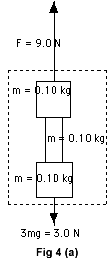 |
|
|
Fnet = Ma
|
|
F - 3mg = (3m)a
|
|
9.0 N - (0.30kg)(10 m/s2)
= (0.30 kg)a
|
|
9.0 N - 3.0 N = (0.30 kg)a
|
|
20 m/s2 = a
|
(b) and (c) To find the tension at the
top of the rope T(b), first use the lower figure
in Fig. 4b below:
|
Fnet = Ma
|
 |
|
T(b) - 2mg = (2m)a
|
|
T(b) – 2(0.10 kg)(10 m/s2)
= (0.20 kg)(20m/s2)
|
|
T(b) - 2.0 N = 4.0 N
|
|
T(b) = 6.0 N
|
|
Check with top figure in Fig. 4b.
|
|
Fnet = Ma
|
|
9.0 N - mg - T(b) = ma
|
|
9.0 N – (0.10 kg)(10 m/s2)
- T(b)
= (0.10kg)(20m/s2) = 2.0
N
|
|
6.0 N = T(b)
|
|
(c) The mass of 1/5 of the
rope
= m/5 = 0.02 kg
|
|
and its weight
= mg/5 = 0.2N.
(d) Use the top figure in Fig. 4c.
|
|
Fnet = Ma
|
|
9.0 N - 1.2 mg - T(c)
= (0.12 kg)(20 m/s2)
|
|
9.0 N – 1.2 N - T(c) = 2.4
N
|
|
7.8 N –2.4 N = Tc
or
|
|
T(c) = 5.4 N
|
|
Using the bottom figure in Fig.
4c
|
|
Fnet = ma
|
|
T(c) - 1.8 mg = (0.18 kg)(20 m/s2)
= 3.6 N
|
|
T(c) = 5.4 N
|
|
|
|
9.
|
(a) For constant velocity, the acceleration
is 0. From the graph of Fig. 5 below we see the applied force
F = 1.0 N when the acceleration equals zero. The intercept
on the applied axis is the frictional force f. In general,
Fnet = ma. For the graph of Fig. 5, F - f
= ma, or F = ma +f (Equation
1). If we compare Eq. 1 to
the equation for a straight line, y = mx + b, we see that
the intercept on the applied force F-axis is the frictional
force f.
(b) The slope of the graph is the mass
of the object.
m = (4.0 - 1.0)N/(0.75 - 0)m/s2 = 4.0 kg.
Eq. 1 becomes F = 4.0 kg a + 1.0 N.
(c) For a = 1.0 m/s2, F = (4.0 kg)(1.0 m/s2)
+ 1.0 N or F = 5.0 N.
(d) For a block of a greater mass, the slope of the graph
increases and the intercept also increases because the normal
force N = mg and f = µN where µ is the coefficient
of friction.
(e) If you change the surface, the intercept f changes because
µ changes.
|
|
|
10.
|
|
(a)
|
 |
| |
(Fnet)x =
max
|
|
(Fnet)y
= may
|
| |
26 N - f = 2.0 kg(ax)
|
|
FN - mg = m(0)
|
| |
|
|
FN =mg=(2.0 kg)(10m/s2)
= 20N
|
| |
|
(b)
|
f = µkFN =
1/5(20 N) = 4.0 N
|
| |
26 N - 4.0 N = 2.0 kg(ax)
|
(c)
|
11 m/s2 = ax
|
|
|
|
11.
|
|
(a)
|
 |
|
(b)
|
(Fnet)y =
may
|
(c)
|
(Fnet)x = max
|
| |
FN + 26 N sin 22.60-
mg = 0
|
|
26 N cos 22.60 - f = 2.0 kg(ax)
|
| |
FN + 26N(5/13) - 20
N = 0
|
|
26 N(12/13) - 2 N = 2.0 kg(ax)
|
| |
FN = 20 N - 26N(5/13)
= 20 N -10 N = 10N
|
|
24 N - 2 N = 2.0 kg(ax)
|
| |
f= µkFN =
(1/5)(10 N) = 2 N
|
|
11 m/s2 = ax
|
|
|
|
12.
|
(a) and (b) The x-axis is chosen in the
direction of the acceleration. The axes, forces and components
of forces are shown in the figure below:
 |
(c)
|
(Fnet)x =
max
|
| |
30 N sin 300 = 3.0 kg(ax)
|
| |
15 N = 3.0 kg(ax) 5.0
m/s2 = ax
|
| |
|
|
|
|
13.
|
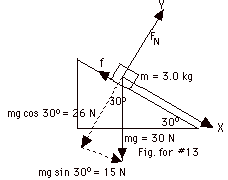 |
|
|
|
(b)
|
Now there is a frictional force
up the plane.
|
| |
(Fnet)y =
may
|
| |
FN - mg cos 300
= 0
|
| |
FN = 30 N (0.866) =
26 N
|
| |
f = µk FN
= 0.154(26 N) = 4.0 N
|
|
(c)
|
(Fnet)x =
max
|
| |
30 N sin 300 - f = 3.0
kg(ax)
|
| |
15 N - 4.0 N = 3.0 kg(ax)
|
| |
11/3 m/s2 = ax
|
|
|
|
14.
|
(a) First isolate m1, taking the X-axis in the
direction of the acceleration.
|
(Fnet)x
= m1ax
|
(Fnet)y =
m1ay
|
|
T - m1g sin 16.30
- f = m1ax
|
FN - m1g
cos16.30 = m1(0)
|
|
FN = 25 N(24/25) = 24
N. f = µkFN = 1/6(24 N) =
4 N
|
|
T - 25 N(7/25) - 4 N = 2.5 kg a
|
|
|
T - 11 N = 2.5 kg a (Equation
#1)
|
I have dropped the subscript on
a, the only acceleration. Now isolate m2, taking
down as positive.
|
Fnet
= m2a
|
| m2g - T = m2a |
|
20 N - T = 2.0 kg a (Equation
#2)
|
Adding Eq. 1 and Eq. 2: 20 N -
11 N = 4.5 kg a, or a = 2.0 m/s2
(b) Substituting a = 2.0 m/s2
into Eq. 2:
20 N - T = 2.0 kg(2.0 m/s2),
and
T
= 16 N.
|
|
|
15.
|
Figure for #15a below is a sketch of
the object moving on the table and all of the forces acting
on it. As the object starts to slip away from the circle,
a frictional force acts into the center of the circle to produce
the centripetal acceleration. I chose the X-axis to the right
because at the moment shown in the picture, the centripetal
acceleration is into the center of the circle or to the right.
The frictional force is the only force into the circle or,
as I have drawn it, along the positive X-axis. This is a three
dimensional drawing showing that for clockwise motion, at
this instant of time, the velocity is along the positive Y-axis.
The weight of the object is always along the negative Z-axis
and the normal force of the table along the positive Z-axis.
Now our axes of interests are the X-axis and the Z-axis. The
acceleration in the positive X-direction is the centripetal
acceleration = v2/r.
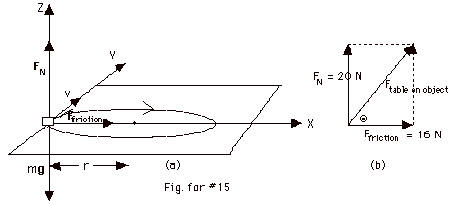
(a) (Fnet external)x
= max
Ffriction =
mv2/r = 2 kg (2 m/s)2/(0.5 m) = 16 N
(b) There is no acceleration in the Z-direction.
(Fnet external)z = maz. FN
- mg = m(0), or FN = mg = (2 kg)(10 m/s2)
= 20 N.
As shown in Fig. for #15b above:
Force of table on object = {(Ffriction)2
+ FN2)1/2
= {(16)2 + (20)2}1/2
= {656}1/2 N
= 25.6 N. tan Θ
= FN/Ffriction = 20/16 = 1.25; Θ = 51.30
|
|
|
16.
|
(a) Net force on sled = msledasled
= 10 kg(2.0 m/s2) = 20 N = force of man on
sled.
(b) By Newton's third law, force of man on sled = force of
sled on man = 20 N.
(c) Net force on man = mmanaman = 60
kg(2.0 m/s2)=
120 N = frictional force of snow on man - force of sled on
man
120 N = frictional force of snow on man - 20 N.
Frictional force of snow on man = 140 N.
|
|
|
17.
|
(a) The centripetal acceleration a =
v2/r = (3m/s)2/0.5 m = 18 m/s2.
The object travels in a counterclockwise direction so the
directions of the velocities are as shown in Fig. 7a above.
Remember the velocity is always tangent to the path. Thus,
(b) at B the velocity is to the right,
(c) at T the velocity is to the left, and
(d) at S the velocity is down.
(e) At B the acceleration is into the center of the circle
or up. At B we take the X-axis up.
(f) At T the acceleration is into the circle or down. At T
the X-axis is down.
(g) At S the acceleration is to the right and the X-axis is
to the right. All of the accelerations are in the direction
of the net force. For all cases Fnet = ma = 2 kg(18
m/s2) = 36 N. Looking at Fig. 7b below, we see
that at B and T, there are no components of the force in any
direction except the X-direction so we drop the subscripts
on Fnet.
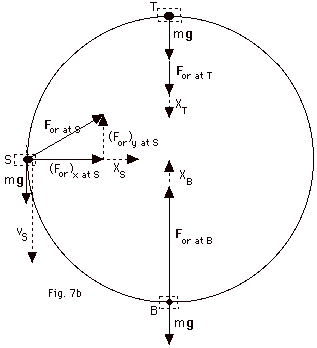 |
(h) At B,
For at B - mg = ma
For at B - 20 N = 36 N
For at B = 56 N
(i) at T, I have drawn For at T down, but I must
use the equation for a final decision so I write it with ±
to find its sign and, therefore, its direction.
Fnet = ma ± For at T + 20 N = 36
N so For at T = +16 N or it is down.
(j) At S, For at S must have a component
into the center or along the +X-axis to produce the centripetal
acceleration and a component along the +Y-axis so the net
force along the Y-axis is zero keeping the magnitude of the
velocity for the uniform circular motion constant. Thus, we
must look at Fnet along the X- and Y-axes.
|
(Fnet)x at
S = max
|
(Fnet)y at S =
may
|
 |
|
(For)x at S
= 36 N
|
(For)y at S -
mg = m(0)
|
| |
(For)y at S =
mg = 20 N
|
| |
|
|
For at S = {(For)2x
at S + (For)2x at S}
|
|
For at S = {(36)2
+ (20)2}1/2 N = 41 N
|
|
tan Θ
= (For)y/(For)x
= 20 N/ 36 N = 0.55. Θ =
290
|
|
|
|
18.
|
(a) Let Fos = the force of
the scale on the object when the elevator moves with a constant
velocity. For constant velocity,
| |
 |
|
Fnet = ma = m(0)
|
|
Fos - mg = 0, and
|
|
Fos = mg = (10 kg)(10
m/s2)
|
|
=100 N
|
By Newton's third law, the force of the
scale on the object = the force of the object on the scale.
The reading of the scale is 100 N.
(b) Let F'os = the force of the scale on the
object when the elevator moves upward with a constant acceleration
of 5 m/s2.
|
Fnet = ma = (10 kg)(5
m/s2)
|
|
F'os - mg = 50 N, or
|
|
F'os = 50 N + 100 N
|
|
= 150 N
|
|
F'os = F'so
= reading of scale= 150 N
|
|
|
|
19.
|
From problem #18, we see that the scale
reading is greater for an upward acceleration. Conversely
the scale reading is smaller for a downward acceleration.
We can explain Fig. 8 below by saying that at first the elevator
accelerates upward, then moves at a constant velocity, and
finally decelerates and comes to rest.

|
|
|
20.
|
Fnet = mg - f = ma or a =
g - f/m. The lead sphere has a greater density than the wood
sphere. The volume of the spheres = 4/3 πr3
and the mass m of the spheres = density x volume. The lead
sphere has the same volume as the wood sphere since their
radii are identical, but it has a larger mass because it has
a greater density. Since a = g - f/m, the sphere of the larger
mass has the greater acceleration.
|
|
|
21.
|
Take the X-axis in the direction of the
acceleration or up the plane and the Y-axis perpendicular
to it (Fig. for #21).

|
|
(Fnet)x
= max
|
(Fnet)y =
may
|
|
F cos 370 - mg sin 370
- f = ma
|
FN - F sin 370
-mg cos 370 = m(0)
|
|
60 N(4/5) - 20 N(3/5) - f = 2.0
kg(a)
|
FN = 60 N(3/5) + 20
N(4/5) = 52 N
|
| |
f = µkFN =
1/2(52 N) = 26 N
|
|
48 N - 12 N - 26 N = 2.0
kg(a) or a = 5.0 m/s2
|
|
|
|